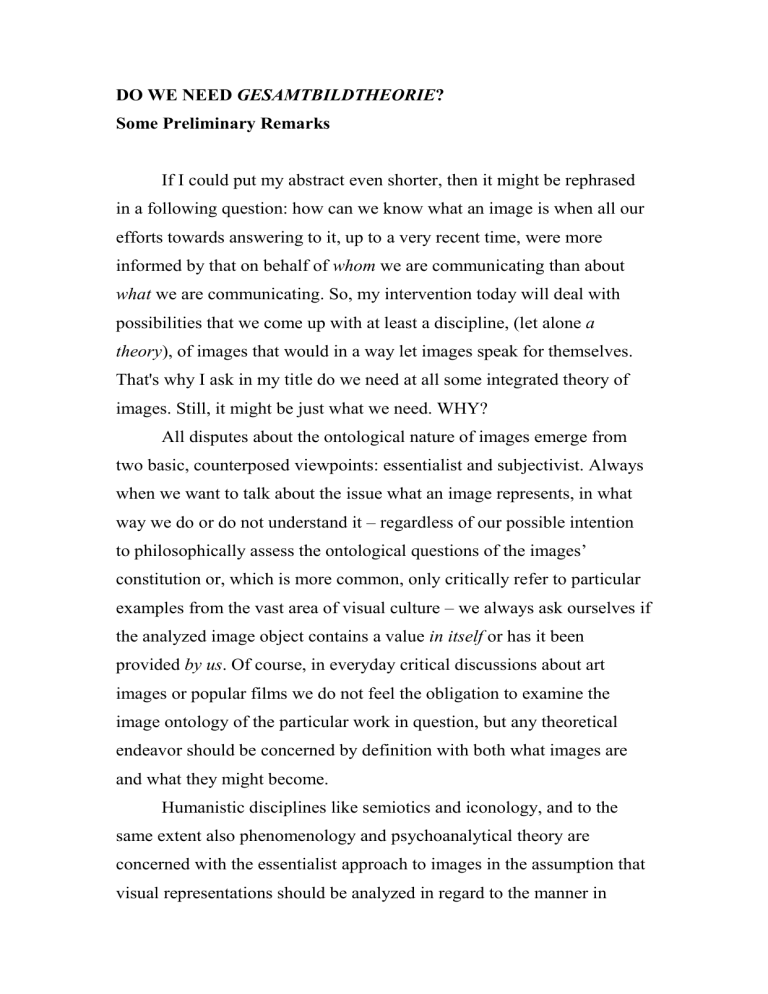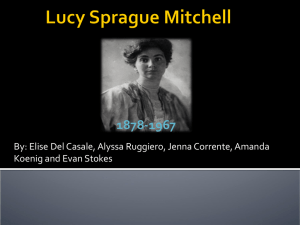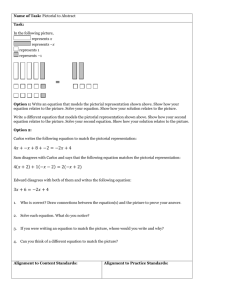Do we Need “Gesamtbildtheorie”? Some Preliminary Remarks

DO WE NEED GESAMTBILDTHEORIE?
Some Preliminary Remarks
If I could put my abstract even shorter, then it might be rephrased in a following question: how can we know what an image is when all our efforts towards answering to it, up to a very recent time, were more informed by that on behalf of whom we are communicating than about what we are communicating. So, my intervention today will deal with possibilities that we come up with at least a discipline, (let alone a theory ), of images that would in a way let images speak for themselves.
That's why I ask in my title do we need at all some integrated theory of images. Still, it might be just what we need. WHY?
All disputes about the ontological nature of images emerge from two basic, counterposed viewpoints: essentialist and subjectivist. Always when we want to talk about the issue what an image represents, in what way we do or do not understand it – regardless of our possible intention to philosophically assess the ontological questions of the images’ constitution or, which is more common, only critically refer to particular examples from the vast area of visual culture – we always ask ourselves if the analyzed image object contains a value in itself or has it been provided by us . Of course, in everyday critical discussions about art images or popular films we do not feel the obligation to examine the image ontology of the particular work in question, but any theoretical endeavor should be concerned by definition with both what images are and what they might become.
Humanistic disciplines like semiotics and iconology, and to the same extent also phenomenology and psychoanalytical theory are concerned with the essentialist approach to images in the assumption that visual representations should be analyzed in regard to the manner in
which an object is represented in the image (semiotics and iconology) or in regard to the ways that the represented object generates visual effects in the mind (phenomenology and psychoanalysis). Irrespectively of the fact that these disciplines consider that visual experience and thus the fundamental constitution of the image takes place in entirely different places – as symbols on canvas or screen, as opposed to perception as bodily experience – they all suppose that there is a universal set of rules applicable either to the reading of the image (semiotics) or the experience of the image (phenomenology), whose implementation brings us closer to the essence (supposedly) of all pictorial representations. If at the very beginning I postulate that the answer to the question what is an image?
is always undeterminable in advance, because it is constantly delineated by the boundaries of the essentialist and subjectivist understanding of images, this does not mean that I do not consider that question worthy of discussion, but propose that it may be addressed in a different – nondisciplinary – way.
In order to explain what kind of difference this is, it is enough to remember Charles Sanders Peirce’s icon-index-symbol image concept on the one hand and the phenomenological idea of Edmund Husserl’s pictorial consciousness on the other. In Pierce the image is either in direct relation to the object (indexical sign) or it is explained through a relation of similarity with the represented object (iconic sign) or it is a result of certain conventions of representation (symbolic sign). In each of these sign variants the source of the image is outside of the observer: in the represented object, in a picture as a physical object or within social codes that define meanings. Nevertheless, although he also shapes the experience of the image through the triadic principle of the cognition process, the moment of perception as the effect of visibility is essential for Husserl. Thus, unlike Peirce or Nelson Goodman, for example, who
2
consider the image more or less a material consequence of impulses coming from the extra-pictorial reality, from the phenomenological point ov view, Husserl thinks that the image object is not substance present in the image, but appearance that only prompts the relation with something absent. This is best seen in the difference established between the material carrier [Bildträger], i.e. the paper or canvas of the picture and the image object [Bildobjekt], i.e. the immaterial likeness made of shapes or paint (that which we really see in the picture).
However, from the standpoint of a possible “general” ontology of the image the differences between these two approaches are smaller than they seem to be, although the gap, as we have seen, between semiotic concentration on pictorial representation and phenomenological insistence on the imaginative potential of the image consciousness seem to be the largest possible. In his Aesthetics of Appearing , Martin Seel argues that there is no clash between the phenomenological and semiotic theory of images, because both disciplines are in principle concerned with
“surveyable surfaces that make something visible”. Seel sees the ontology of the image as philosophically superimposed to different disciplinary approaches, because the latter ones offer us the possibility of discussing images only after we are sure that the phenomenon or the object we would like to discuss is actually an image. Therefore I think that we can consider Seel’s statements as an introduction to the version of the image science constituted as a dialectic relation between the perceptual and the imaginative image – two basic directions in the contemporary theory of images. My arguments will lead towards a proposal of supplementing this pictorial dialectics by a new method inspired by Seel’s hybrid philosophy of images, but also, to an even greater extent, by Thomas Mitchell’s disciplinary “deconstruction” of the image, Hans Belting’s pictorial anthropology, and the reference to the concept of mediality and logic of
3
iconic structures by Dieter Mersch. Finally, I shall try to derive that which will be termed “non-disciplinary ontology” of the image.
Unlike the mentioned essentialist approaches, which treat the image as an object to which both the sense and the meaning are immanent
(the so-called “metaphysics of pictorial presence”), subjectivist approaches are based on the functions and interpretations of images in relation to (or by) the individual viewer or a group of viewers within different and often incomparable social contexts of visual culture.
Certainly the best known among them are the disciplines that emerged from post-structuralism and cultural studies, which are today mostly encompassed by generic notions like “visual culture” and “politics of identity”. Opposite to Jonathan Crary and his insistence on technologies of observation as most essential for the turn in ways of looking, Irit
Rogoff maintains that “in visual culture the history becomes that of the viewer or that of the authorizing discourse rather than that of the object”.
Keith Moxey comments on the shift of the focus of scholarly interest from universal disciplinary insights towards the practical observer as follows: “In contrast to poststructuralist theory, language is no longer regarded as the privileged medium through which we come to know both ourselves and the world [because] language has a performative status in the production of meaning”.
According to Moxey, Mitchell’s concept of the pictorial turn is one of the most important proofs that image objects have developed the ability to withstand the meanings ascribed to them by entire generations of their interpreters. Therefore, visual studies not only undermines the idea of epistemological universality, but it explicitly excludes it in some of its theoretical options. For example, Mitchell’s famous question “what do pictures want?” disables a (single)-disciplinary approach to images, because the assumption is that images themselves will impose ad hoc
4
theoretical or practical positions from which they “want” to be viewed and that these must not necessarily be the positions intended for them within the framework of semiotics, traditional iconology, psychoanalysis, phenomenology or a sort of politics of identity.
Belting’s concept of “living medium” is close to Mitchell’s concept of “living pictures”, but it is also opposed to it. In order to explain the role of people in the production of images, not as physical objects but as objects in the mind, Belting states that in the German language there is a difference between memory [Gedächtnis], which means image archive, and remembrance [Erinnerung], which is the activity of collecting images. He discovers that people simultaneously own and produce images. This German theorist says that in both cases our body, our brain, serves as a “living medium” that enables us to perceive, send, and recall images in the memory, same as our body enables our imagination to reshape and censor them.
As we may assume, subjectivist approaches can be related, and mostly are , to groups of subjectivities connected by common interests in the affirmation of political, gender, sexual, national or other values. As opposed to that, the English theorist Janet Wolff maintains that there exists something called “the magic of the image”, impossible to be explained with the help of individual disciplines as discursive practices within a humanistic theory. She states that recently we have witnessed a series of attempts by the members of the humanistic scholarly community to prove that the ideological positions of cultural studies have become insufficient to encompass the new technological and post-humanistic reality of images and visual representations. Instead of focusing the attention on social and historical conditioning of scopic regimes, Janet
Wolff proposes the return to the affirmation of social insights into the status of artworks and images in general, although she admits that
5
“emotional and affective sides of private and social life have been fully neglected in critical theory, cultural theory, and aesthetics”. What Janet
Wolff actually does is, on the one hand, transcendig of approaches of
“new subjectivists” and, on the other, overcoming of essentialist masterscience. If images have power, says she, then this is because people have yielded them that power in the circumstances in which images could not have activated and made alive just by themselves: “We can recognize the power of the images, while understanding full well that that power is
(socially, culturally, perhaps politically) given to them”.
Even more to the point is Gottfried Boehm who asserts that the contemporary ontology of images is not at all an essentialist question of the general status of the image, but that the current terminology can only refer to “ this picture and this drawing”, that is the status of a concrete phenomenon. Boehm’s anti-metaphysical argumentation of sorts follows from his specific “logic of the image” characterized by hybrid “iconic logos”. The understanding of the image as an entity with its own logic and sense is unambiguously essentialist motivated, but, unlike most disciplinary practices developed during the 20 th century, Boehm’s approach does not strive towards a set of rules, signifier dogmas or perceptual and affective agencies of the image, although he often refers to them. With his concept of iconic difference , and the attempt to answer the question what does the logic of images mean?
, he primarily tries to equally detach himself from essentialist and subjectivist approaches and to come closer to the immanence of images of sorts, but not in the sense of the hermeneutics of the individual artwork by Hans Georg Gadamer, but by pointing at 1) the characteristic of the image surface that makes it detachable from the continuum of reality as a surface where not only something “happens”, but where something is “shown” and 2) the ability of man to see something in something else, that is to see something “in
6
the light of the other”. It is clear from these two basic postulates that the notion of iconic difference must necessarily be viewed from at least a hybrid, semiotic-phenomenological position. This becomes clearer insofar as Boehm’s iconic difference is related to the image as a different category that contains a “surplus of the imaginary” and provides a
“context for visual differentiation”.
In a clear reference to Boehm, Dieter Mersch states that already the definition which assumes that seeing an image primarily means seeing something like an image and then seeing something that it depicts requires from us the acceptance of the duplicity of pictorial ontology: namely a picture can be interpreted as image , but also as a mere object that makes something visible. Mersch considers the difference between the matter and the phenomenon, i.e. the pictoriality and making visible the key point of ontology of the image. Mersch’s acceptance and then also the overcoming of the iconic difference can be recognized in his assertion that images speak less and communicate less to their viewer than they show him. How they show is not connected to either observation or understanding, but to some new ontology. Again we find here an inherent logic of the image . Along the lines of this argumentation we can infer that any visual difference must be recognizable as a distinctive visual symbol, but it does not necessarily need to be semiotically relevant; it can be mere evidence or a cognitive fact. Insight into these differences can be established through narrative or figurative image strategies, but also apart from them. We can recognize them through a multitude of referential effects of images, equally through their relation to nature and the relation to themselves. We can recognize them, for example, as ontology of materiality or ontology of time .
The first significant theoretical contribution that attempted to relativize the discursive models of interpretation of images was Mitchell’s
7
Iconology published in 1986, which especially refers to the often mentioned chart of the “family of images” from the very beginning of this book. It is interesting that a few years after Iconology Mitchell derived his
Pictorial Turn from an entirely different position, as a kind of a new
“image urgency” at the end of the 20 th century, and not as a proposal for a non-discursive ontology of the image, which the mentioned chart and its appertaining commentary already contained as indication. If we ask the question why after that Mitchell has not reverted to ontological questions related to the image, as one of the possible reasons we can offer general differences between visual studies and Bildwissenschaft – which was addressed in different occasions by Keith Moxey, Matthew Rampley, and
Jason Gaiger. All three of them talked about the gap between the primary social and ideological interest for the image in the Anglo-American school on the one hand and the interest for the nature and functioning of the image as such in the German school on the other.
1 The gap in the understanding of the nature of images is very conspicuous between, for example, “late” Mitchell and Dieter Mersch or Klaus Sachs-Hombach, but this chart of the “family of images” already contains some essential elements of non-disciplinary ontology which, as this became evident, would be more characteristic of the German school.
What could, therefore, be so revolutionary in the introductory chapter of Mitchell’s Iconology ? Especially because the links between the arts and other areas of visual culture (popular magazines, movies) have already been problematized by Aby Warburg and the German art history of the first half of the 20 th century, as this has been convincingly demonstrated by Horst Bredekamp in his article Art History as
1 Keith Moxey, op.cit.; Matthew Rampley, “ Bildwissenschaft : Theories of the Image in
German-Language Scholarship“, in: Rampley, Lenain, Locher, Pinotti, Schoell-Glass,
Zijlmans (eds.), Art History and Visual Studies in Europe , Leiden and Boston: Brill, 2012;
Jason Gaiger, “The Idea of a Universal
Bildwissenschaft
“, Estetika: The Central European
Journal of Aesthetics, LI/VII, 2014, No. 2/50.
8
Bildwissenschaft.
2 On top of that, we can observe the shift of the scholarly interest from stylistic and historical to cultural topics within the
Western history of art already in Michael Baxandall’s and Svetlana
Alpers’ “new art history”, for example.
3 Mitchell’s point of departure was that visual insights could exist in a very wide area delineated by images as objects on the one hand and images as pure perceptual phenomena on the other. The reality of each image is constituted in the ability of the viewer to be aware of the possibilities of pictorial evidence at any moment. Therefore, the decisive question for Mitchell is not the one of discipline that we might choose and apply to individual pictures. It is also not decisive for him what kind of images we focus on (artistic, scholarly or fashion-related); for him, already then (before the pictorial turn and before Bildwissenschaft in the narrow sense), the crucial element was the shifting modality of pictorial appearing – that which was later in more detail developed by Martin Seel in the mentioned “Thirteen Statements on the Picture” or Dieter Mersch in his “Logic of Iconic Structures”, which are both the fundamental preoccupation of the German image science.
Mitchell has spotted a conspicuous problem with the semiotic typology insofar as Peirce classified his sign system only in relation to the physical world in order to re-systematize it within signs as physical objects. According to this concept, physical images are signs whose connection to the denoted object can be established in various ways.
2 See about art historical foundations of the German image science in: Horst Bredekamp, “A
Neglected Tradition: Art History as Bildwissenschaft
?“, Critical Inquiry, No. 29/2003.
3 See well-known studies by Michael Baxandall, Painting and Experience in Fifteenth-
Century Italy. A Primer in the Social History of Pictorial Style ; Oxford: Clarendon Press,
1972 and Patterns of Intention. On the Historical Explanation of Pictures ; New Haven,
London: Yale University Press, 1985; as well as Svetlana Alpers, The Art of Describing.
Dutch Art in the Seventeenth Century ; Chicago: University of Chicago Press, 1983. Also instructivve is the overview of new art history by Jonathan Harris, who focuses on its socialcritical role. See J. Harris, The New Art History. A Critical Introduction , London and New
York: Routledge, 2001.
9
However, images that dwell in the language as non-material signs, that is the ones that create the imaginative potential in the mind of the reader demand a different approach. In order to also classify the kind of images that can be perceived outside the established semiotic systems, it is necessary to detach oneself from the division in only those categories or notions that point to other categories or notions with which the former ones are in more or less direct relation. Insisting on the image as a referent of some initial event always leads us to concepts like sign, simulacrum or replacement for the original experience. The semiotic discourse on the image is actually a discussion on the possibilities and conditions of a certain medium to show the physical world and not a discussion on that world itself. Mitchell attempted to approach images in an anti-semiotic fashion, by classifying them according to their way of appearance, unlike the semiotic division of images according to the manner of reproduction of actual events, objective reality and the like. In his Iconology we find a division into five basic kinds of images: graphic, optic, perception-related, mental, and verbal (graf).
This concept is significantly opposed to Boehm’s determination of the image as iconic difference. Understanding Boehm’s achievements – but also limitation – Dieter Mersch adopts the phenomenon of difference, but he adds the assertion that the concept of difference – or “framework” as he calls it – is necessarily defined by two characteristics: primarily by the ability of the image to detach itself from the rest of reality and then also by its characteristic to make something visible as a depiction on itself of something else. It is interesting that Mitchell’s early concept of image ontology does not approach that problem from the standpoint of the general definition what an image is, but approaches it as ontologically unndeterminable, recognizing images through different modalities within which different kinds of pictorial experience can be grouped. He
10
compares them to that which Foucault calls “figures of knowledge”. In spite of that, Mitchell also thinks that there is something like the authentic concept of the image “as such”, but this concept should rather be a subject of institutionalized discourses of philosophy and theology. Is not the German Bildwissenschaft primarily (or at least among other things) a philosophy of the image? Couldn't be that the philosophical foundation recognized by Mitchell as a path towards the ontology of the image? I should explain this little bit more...
Dieter Mersch supports Mitchell’s original idea that the essence of the existence of images can be established only through the application of different but in principle non-disciplinary theories when he says that all attempts to reduce visual strategies to the rhetorical and semiotic, to language allegories and figures like ekphrasis and metaphor, have proved unsuccessful. He insists that we start from the principle of irreducibility of the image to discursive practices, of the fundamental incommensurability “which will define the relation of the image and the gaze as a special media format that requires different means than the ones adopted from the sign theory, literary or language science”. One of these targeted, universal principles of understanding images is for Mersch the phenomenon of chiastic structure of the look , i.e. the ability of the image to make something visible by constant provoking of the interchange of the observer’s view between three ontological extremes: a) image and non-image; b) iconic difference and immersion; c) framing and deframing. Here we see that for pictorial evidence or appearing the medial basis and the depicted content are equally important. The medium allows for a certain fracture in perspective so that we can recognize something like an image on the one hand, while the image itself demands refraction in order that it can be recognized as a medium . However, for such an operation it is necessary that we have neither essentialist nor subjectivist
11
concepts of the image, because disciplines based on them – like traditional iconology, semiotics or gender and Marxist theory – would always lead us only towards the image and its hermeneutics and we would not take mediality of image into consideration, i.e. that to which
Mitchell and Mersch direct us and which I would like to call modalities of pictorial appearing .
When we compare, for example, graphic and optic images (a portrait and the image of the portrayed person in the mirror), it will be much more difficult to determine the fracture in the point of view in one and the other image type than if we compare a graphic and a mental image. Between a photograph and a mirror image of a person the difference does not have to be large in hermeneutical sense (it can even be unrecognizable), while in the ontological sense this difference is decisive. It can, on the one hand, be so tiny that we are often not aware if something is representation or a mirror image, while on the other it opens a large area of non-discursive sense that no semiotic or phenomenological analyses can resolve. Some art practices, like hyper-realism or closedcircuit video installations are focused precisely on this phenomenon. This tells us that image ontology based on discursiveness and narrativity – the classic, gender or psychoanalytical history of art, for example – always feels the need for symbolic marking of the difference, while the areas of the image between ontological extremes about which Mersch speaks will always remain empty because disciplinary theories of meaning have a different purpose and methods. On the other hand, Mitchell’s nondisciplinary family of images can become one of the ways in which
Mersch’s fracture in looking , as the dialectics of the image and mediality, can be fully taken into account.
If now we return to the dichotomy we began this text with, to the essentialist and subjectivist understanding of reality, that is disciplinary
12
theories and politics of identity, we can observe that the mentioned approaches by Mitchell and Mersch do not belong to either of them. The postulate I am putting forward here is that this is because visual studies and Bildwissenschaft are basically non-disciplinary practices, which, as we have seen, remain open for the questions of identity (especially the ones inspired by Nicholas Mirzoeff’s visual culture ), but these questions are not considered epistemologically relevant as an answer to the question what images want and not what observers want.
The theoretical positions I call essentialism and subjectivism are not new. For example, the classic discussion by Gotthold Ephraim
Lessing from 1766, titled Laokoön oder Über die Grenzen der Malerei und Poesie in many of its elements anticipates some of the current most important points of discussion about the boundaries of media forms. In the humanities we are well aware of Lessing’s choice that openly ascribes to poetry a superior role in spiritual creation, while painting is for him a
“media” or visual prosthesis which has a communicative function, but is unable to reach the imaginative potential of poetry. Paradoxically,
Lessing’s theses prove to be vital also for the considerations of mutual interactions of disciplinary borders that I talk about here. I think that
Lessing’s essay on the delineation of artistic media anticipates the contemporary boundaries between essentialist and subjectivist approaches to the image.
In a brilliant study Archeologies of Vision: Foucault and Nietzsche on Seeing and Saying Gary Shapiro put forward the assertion that what in
Lessing looks like a search for the “metaphysics of genre”, i.e. the essence of different art types, actually masks the “politics of genre” i.e. the determination how a particular art genre needs to be understood in relation to its function and possibilities. If we accept Shapiro’s assertion, we can see that ideological questions have determined the boundaries of
13
the interpretation of images, even if cloaked in the metaphysics of genre or, which is more common today, the metaphysics of presence. Gary
Shapiro thinks that Lessing's Laokoöns already represents the universal fear of unlimited potential of art. In such an approach, for example, ekphrastic poetry could never be viewed as a mental image.
Gary Shapiro points to Friedrich Nietzsche as a “post-modern” author who already in his Birth of the Tragedy in several places pleads for an active interrelationship between poetry and painting – “the Apollonian and Dyonisian duality” – because only a blend of opposed principles of logic and intuition can lead to a Gesamtkunstwerk, envisioned by Richard
Wagner – a spectacle of words, images, and sounds. Shapiro adds that it was Nietzsche who pointed out that the theory of art demanded from us to understand both the creation and the reception of art as a wholesome work of human beings in their entirety. In this “post-modern” perspective, the theories of genre and media would be replaced by constant blending of art forms and theoretical approaches, which would open to us new areas of the visible in the images of our time and times gone by. For this reason, we must once again remind that Wagner’s and Nietzsche’s romantic Gesamtkunstwerk today needs its equally romantic
Gesamtbildtheorie that will overcome the division into Apollonian and
Dionysian principles or essentialst and subjectivist approaches, so that visual studies and Bildwissenschaft , as two “neo-Nietzschean” theories, as I dare to call them, could adopt new modalities of pictorial appearing .
These modalities of pictorial appearing are extremely important for our discussion, but they must be treated separately at a different occasion.
14







